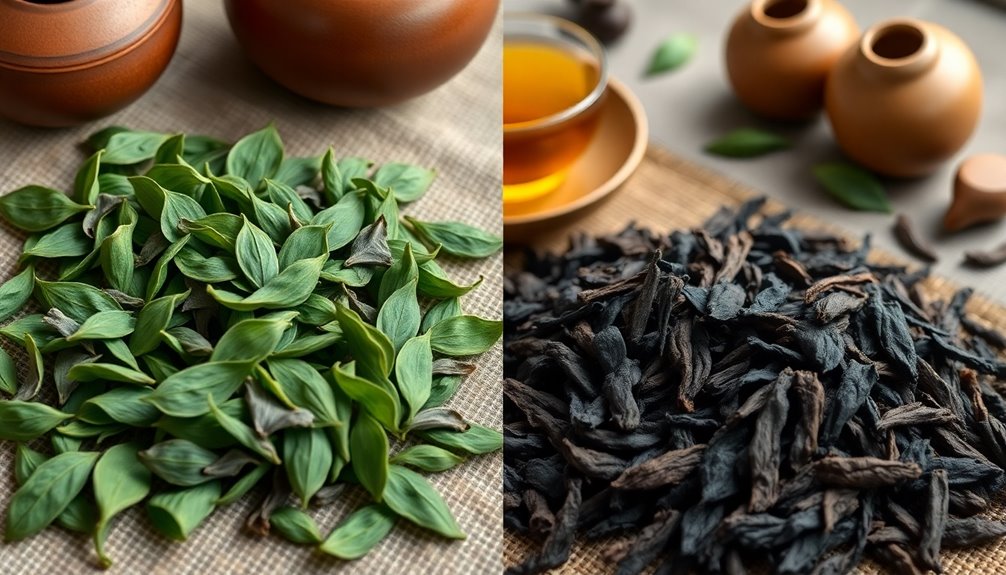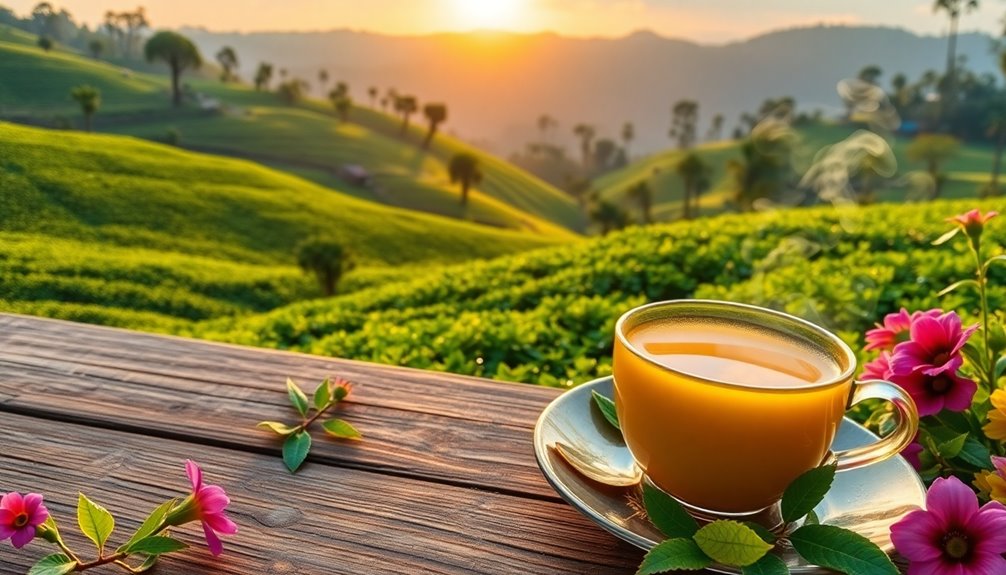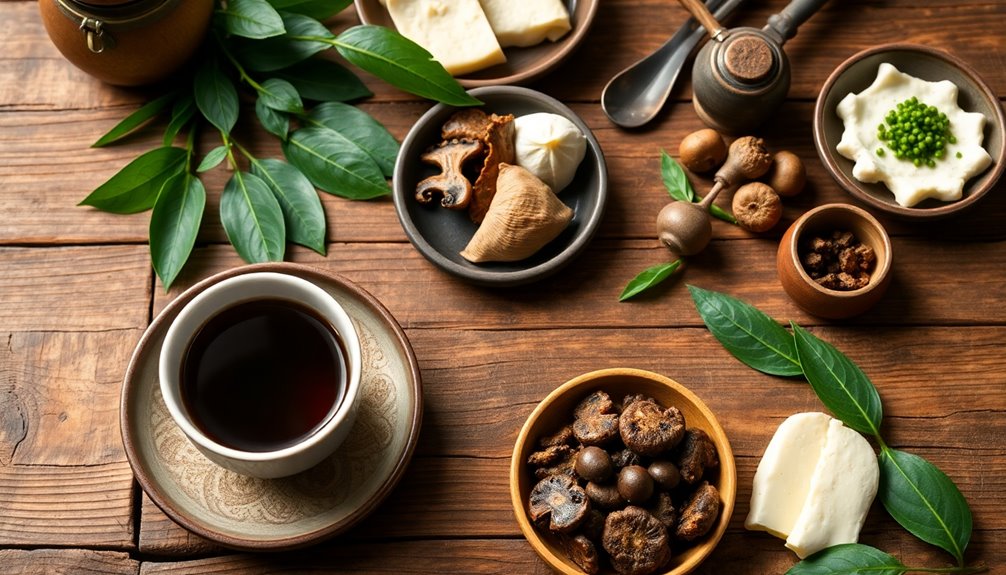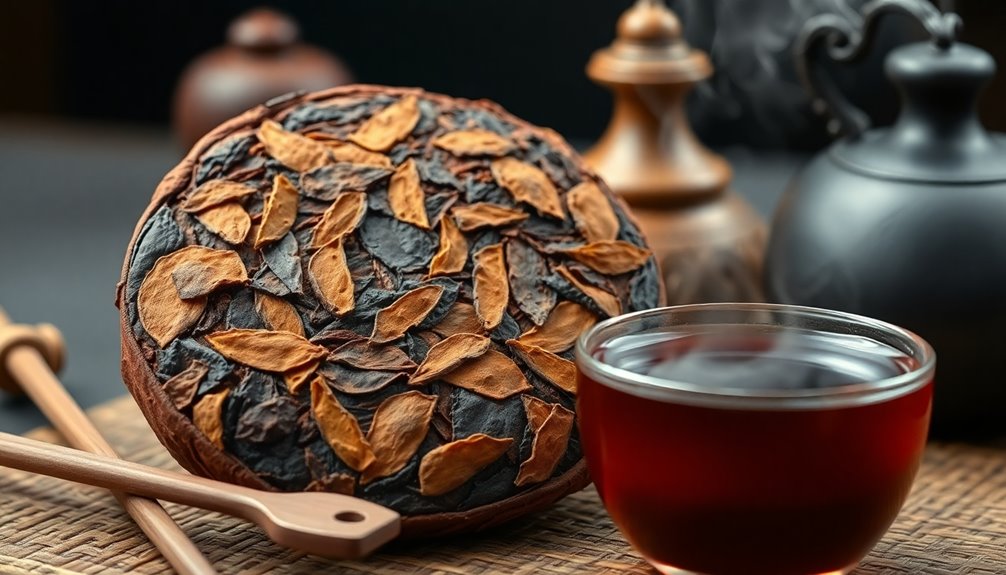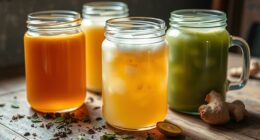Raw pu-erh tea and ripe pu-erh tea are different mainly because of how they're processed and their aging. Raw pu-erh is minimally processed and ages naturally, giving it fresh, grassy flavors that change over years. In contrast, ripe pu-erh goes through a quick fermentation process, resulting in bold, mellow tastes that stay consistent. Visually, raw pu-erh has lighter green leaves, while ripe pu-erh has darker reddish-brown ones. When you enjoy these teas, you'll notice distinct flavors and experiences from both types, making each sip unique. Stick around to uncover even more fascinating facts about these delightful teas!
Key Takeaways
- Raw pu-erh (sheng) is minimally processed and ages naturally, while ripe pu-erh (shou) undergoes a wet-piling fermentation process for quicker readiness.
- Raw pu-erh starts with grassy and floral notes, evolving in flavor complexity over time, whereas ripe pu-erh features consistent earthy, leathery flavors.
- Raw pu-erh has lighter green leaves, while ripe pu-erh displays darker reddish-brown leaves, indicating their different processing methods.
- The aging process of raw pu-erh can take decades, allowing for deeper flavors, while ripe pu-erh is ready to drink in 2-7 weeks.
- Ripe pu-erh is gentler on the stomach due to fermentation, while raw pu-erh offers health benefits like weight loss support through tea polyphenols.
Introduction
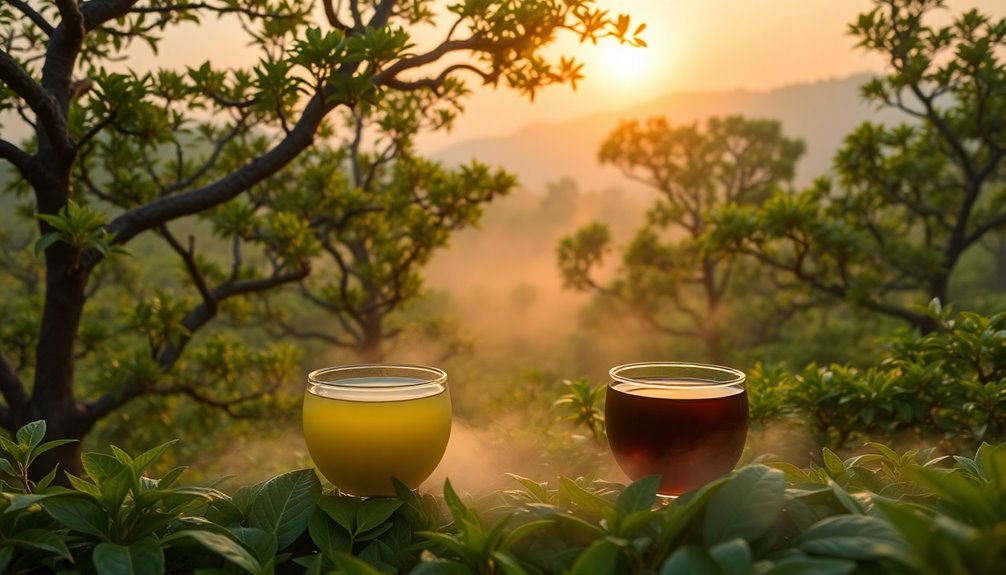
When it comes to pu-erh tea, understanding the difference between raw and ripe varieties is essential for any tea enthusiast.
Raw pu-erh, also known as sheng, is minimally processed and ages naturally over time. This means its flavor can change significantly, starting with grassy and floral notes before developing into smoother, earthy tastes.
On the other hand, ripe pu-erh, or shou, undergoes a fermentation process called wet-piling, which speeds up aging. This results in a bolder, mellower flavor that stays pretty consistent.
Visually, raw pu-erh has lighter green leaves and produces a bright yellow tea liquor, while ripe pu-erh features darker reddish-brown leaves, yielding a dark red tea liquor.
When you think about aging potential, high-quality raw pu-erh can last for 40-60 years, while ripe pu-erh usually lasts about 20 years due to its quicker processing.
You might notice price differences, too. Ripe pu-erh generally costs less because of its shorter aging time and lower production costs.
Now that you know the basics, you're better equipped to explore the world of pu-erh tea!
Processing Methods Differ Significantly
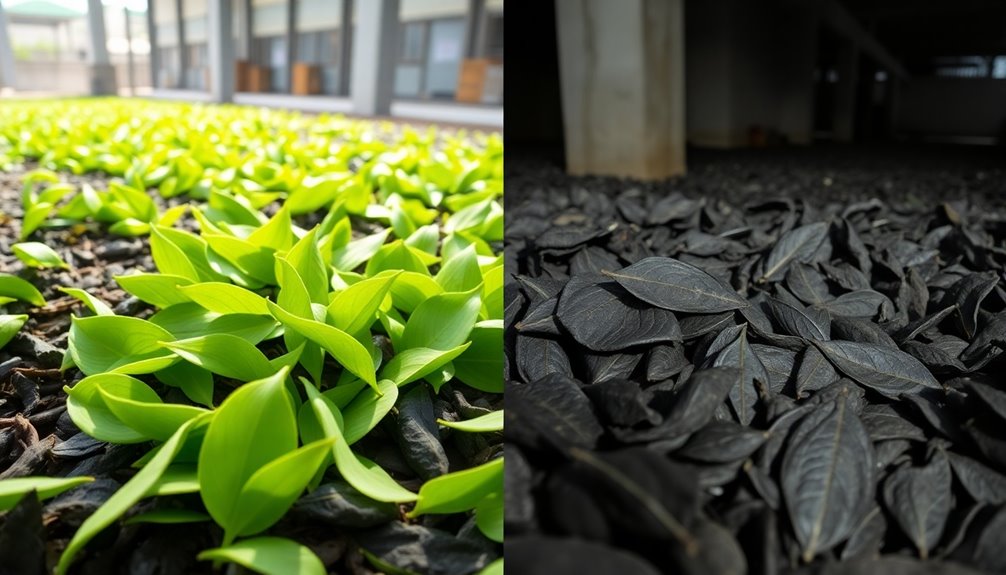
The processing methods for raw and ripe pu-erh tea diverge significantly, shaping their unique flavors and characteristics.
Raw pu-erh tea starts with minimal processing. It goes through steps like withering, pan-frying, rolling, sun-drying, and then ages naturally. This slow aging process can take decades, allowing the flavors to develop gradually.
On the other hand, ripe pu-erh is made using an accelerated fermentation method called wet-piling, which takes only 2 to 7 weeks. During this process, moisture levels are carefully controlled to boost microbial activity, which significantly influences the flavor.
Unlike raw pu-erh, which retains a bright green color due to minimal oxidation, ripe pu-erh ends up with darker, reddish-brown leaves after fermentation and drying.
While raw pu-erh is pressed into cakes and requires patience to enjoy, ripe pu-erh is ready to drink much sooner.
Flavor Complexity Varies Greatly
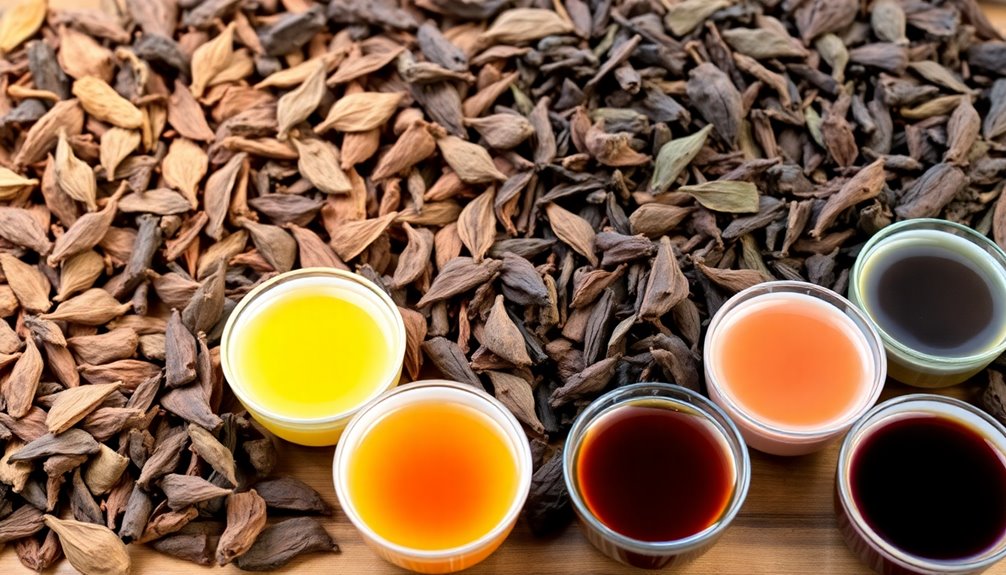
Flavor complexity in pu-erh tea varies greatly between raw and ripe varieties, offering distinct experiences for tea lovers.
If you enjoy a wide range of flavors, raw pu-erh is your best bet. Young raw pu-erh has grassy, bittersweet, and floral notes that change as it ages, leading to deeper, richer flavors over time. It's like watching a story unfold with each sip!
On the other hand, ripe pu-erh delivers a more consistent taste. Thanks to its accelerated aging process, you'll find earthy, leathery, and mellow characteristics that stay stable over time. You might appreciate the boldness of ripe pu-erh right away, as its flavor complexity doesn't shift as much.
As raw pu-erh continues to age, it loses its initial bitterness and gains a smooth, rich taste. Meanwhile, ripe pu-erh maintains its bold profile after a shorter aging period.
Both types undergo microbial fermentation, which plays a key role in their flavor evolution.
Cultural Significance in Tea Ceremonies
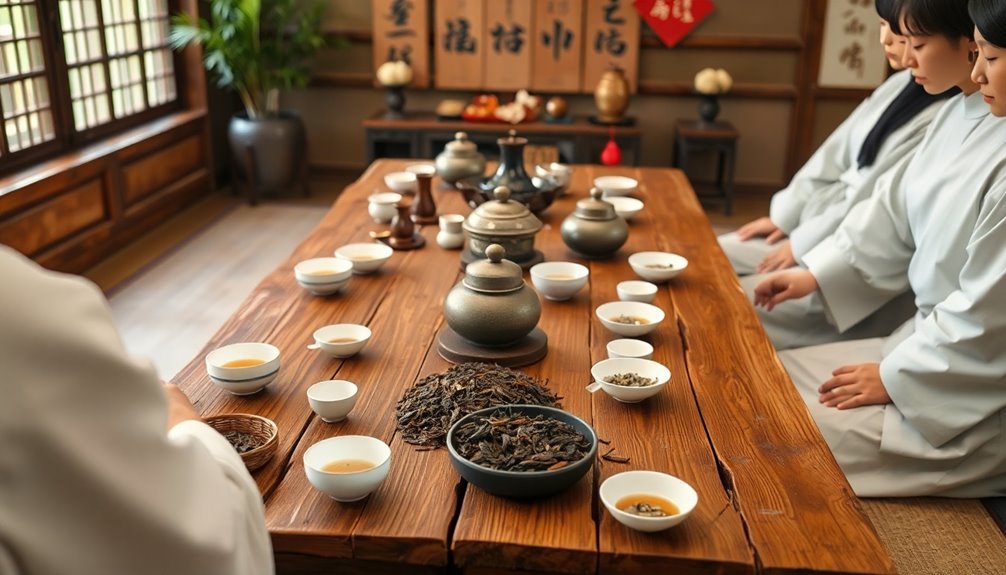
Embracing the cultural significance of pu-erh tea in ceremonies reveals a rich tapestry of tradition and connection. When you participate in tea ceremonies, the choice between raw pu-erh and ripe pu-erh isn't just about taste; it reflects personal preferences and cultural heritage.
Raw pu-erh, known for its evolving flavors, is often the star of ceremonies that focus on nature and time. This tea symbolizes the journey from young to aged, reminding you to appreciate life's changes.
On the other hand, ripe pu-erh shines in social gatherings and casual tea ceremonies. Its bold and mellow flavor makes it perfect for sharing with friends or family, creating a relaxed atmosphere.
In these ceremonies, the presentation matters too! You might find intricate teaware like yixing teapots or gaiwans, specially chosen to enhance the tasting experience and respect the tea's unique qualities.
Brewing and sharing pu-erh tea becomes a communal activity, sparking conversations and building connections. This highlights tea's deep-rooted cultural significance in Chinese society, making each sip a part of a larger story.
Health Benefits Debate
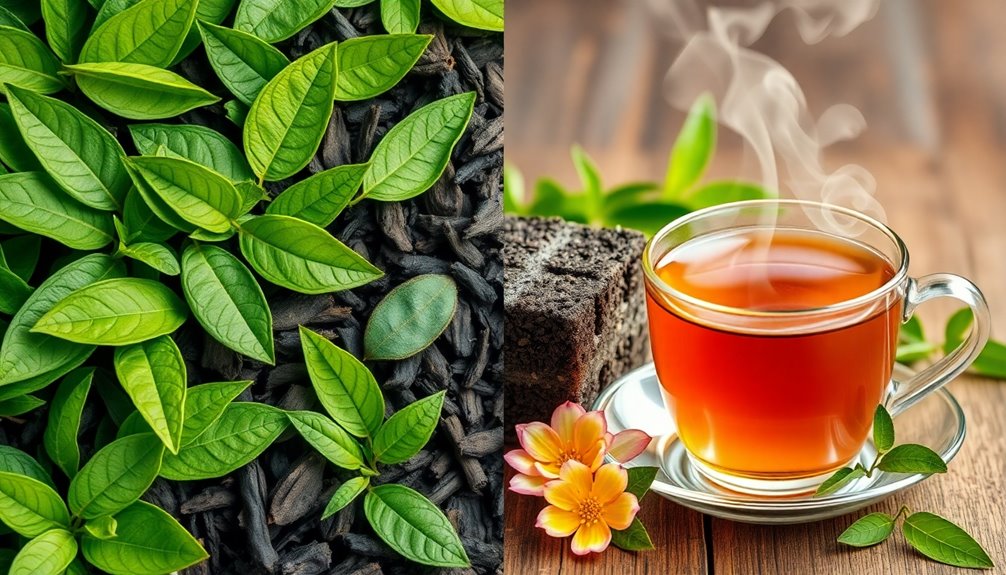
When it comes to health benefits, pu-erh tea sparks an interesting debate between raw and ripe varieties. Both types are packed with antioxidants, which may support your health, aid digestion, and help with weight management.
However, their specific benefits can differ. Ripe pu-erh is often gentler on your stomach due to its unique microbial content. It has beneficial bacteria, amino acids, and minerals developed during fermentation that can improve gut health.
On the other hand, raw pu-erh is rich in tea polyphenols. These compounds are believed to inhibit fat synthesis, making it a great choice for those focused on weight loss and metabolic health.
The aging process of raw pu-erh can enhance its beneficial properties over time, while ripe pu-erh's benefits stabilize after fermentation.
If you're looking for a tea that boosts mental alertness, ripe pu-erh might be your best bet, thanks to its probiotic content.
Ultimately, both varieties offer impressive health benefits, so you can choose based on your personal preferences and wellness goals. Enjoy exploring the unique advantages each type has to offer!
Practical Applications
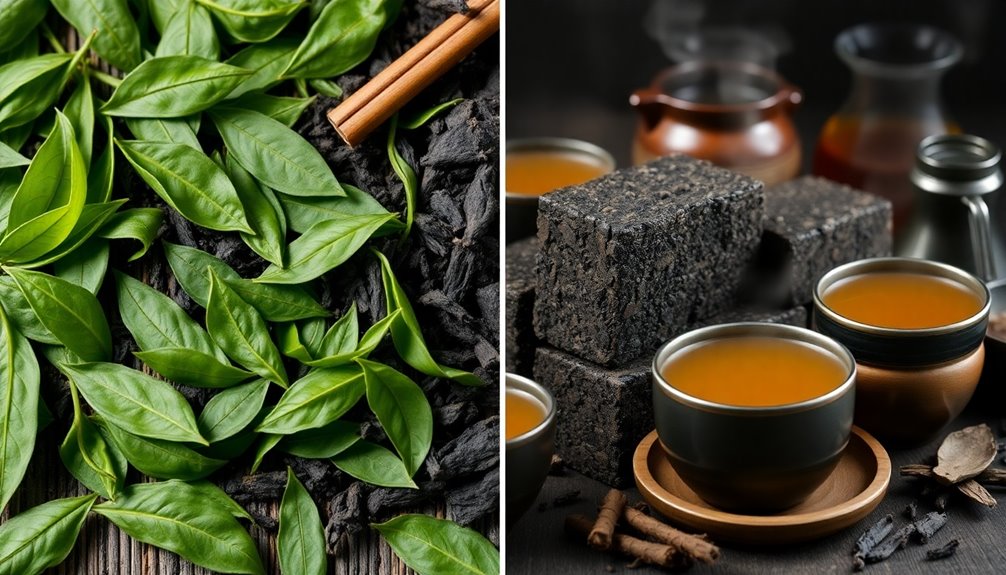
Choosing between raw and ripe pu-erh tea can greatly enhance your tea-drinking experience depending on your preferences and goals.
If you enjoy complexity in flavor, raw pu-erh is your best bet. It evolves beautifully over the years, starting with grassy and floral notes and maturing into earthy flavors. This tea is perfect for those who appreciate patience, as it can age for 40-60 years.
On the other hand, if you prefer a bolder and richer taste right away, ripe pu-erh is your go-to. Thanks to its accelerated fermentation process, this tea develops its flavor in just 2-7 weeks. It's also easier to brew; just use boiling water to extract its robust taste.
When storing your teas, remember that raw pu-erh needs cool temperatures and low humidity to age properly, while ripe pu-erh is more forgiving.
With these insights, you can confidently choose between raw and ripe pu-erh to suit your mood or occasion. Whether you're sipping a delicate raw pu-erh or a hearty ripe pu-erh, you're sure to enjoy a delightful experience!
Frequently Asked Questions
Is Ripe or Raw Pu-Erh Better?
Whether ripe or raw pu-erh is better depends on your taste. You might prefer raw for its evolving complexity or ripe for its smooth consistency. Explore both to find which resonates with your palate.
What Is Raw Puerh?
Raw pu-erh tea's made from non-fermented leaves that age naturally, developing a complex flavor profile. You'll notice bright yellow liquor and a range of tastes, evolving from grassy to earthy as it matures over time.
What Are the Two Types of Pu-Erh Tea?
There are two main types of Pu-erh tea: Raw (sheng) and Ripe (shou). Raw Pu-erh has a slower fermentation process, while Ripe Pu-erh uses accelerated fermentation, creating distinct flavors and aging potential for each type.
Is Raw Pu-Erh Cooling?
Yes, raw pu-erh's cooling properties can help you balance internal heat. With its grassy flavors and high tea polyphenols, it's great for digestion, especially when enjoyed after meals or brewed with cooler water.
Conclusion
In summary, raw pu-erh and ripe pu-erh tea offer unique tastes and experiences. Their different processing methods create distinct flavors, and each has its own cultural importance. While both types may have health benefits, the debate continues. Whether you're sipping a cup during a tea ceremony or enjoying it at home, exploring these teas can be fun and rewarding. So, go ahead, try them both, and discover which one you like best!

